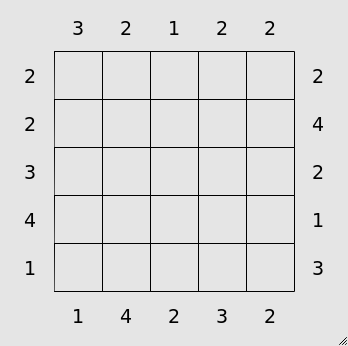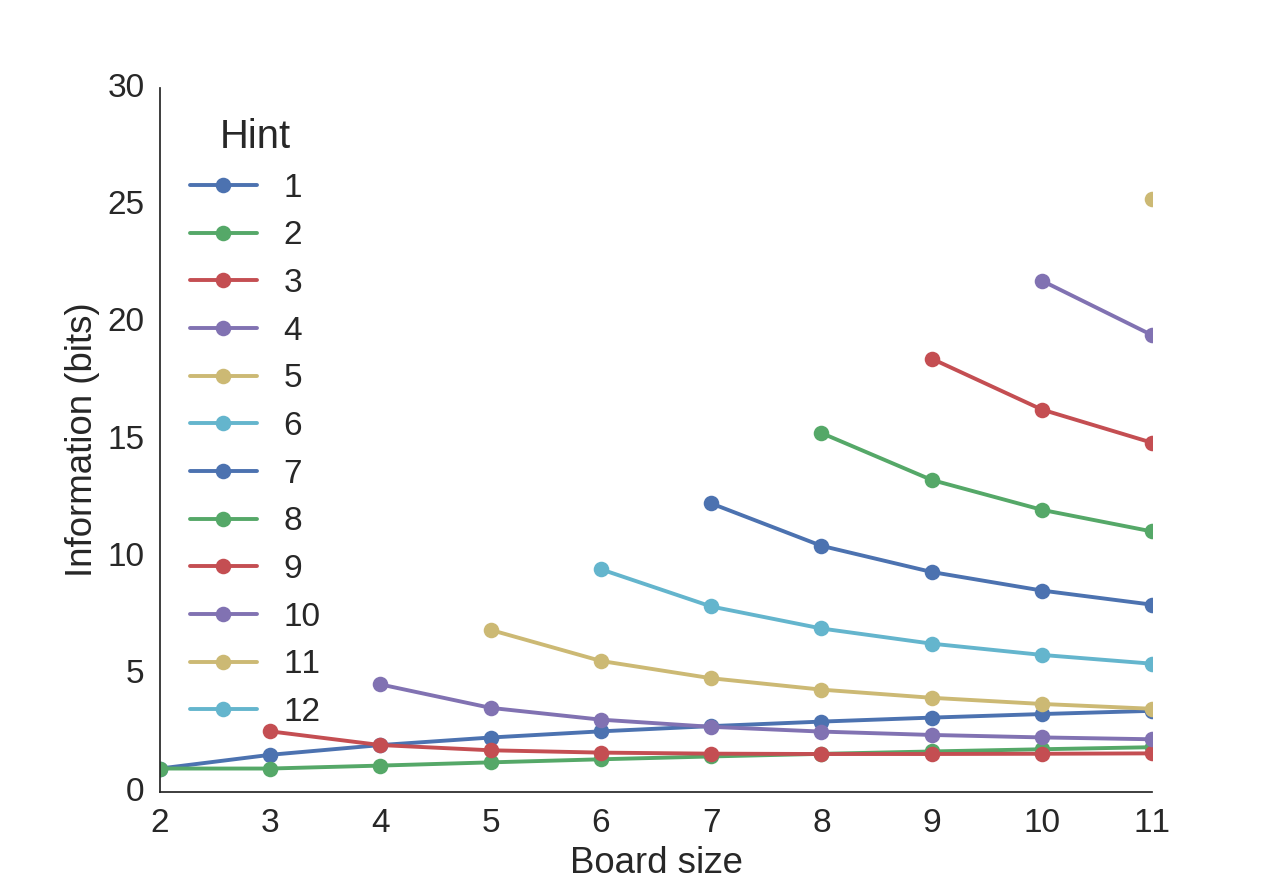Which hints are best in Towers?
There is a wonderful collection of puzzles by Simon Tatham called the Portable Puzzle Collection which serves as a fun distraction. The game “Towers” is a simple puzzle where you must fill in a Latin square with numbers \(1 \ldots N\), only one of each per row/column, as if the squares contained towers of this height. The number of towers visible from the edges of rows and columns are given as clues. For example,

An example starting board from the Towers game.
Solved, the board would appear as,

The previous example solved.
In more advanced levels, not all of the hints are given. Additionally, in these levels, hints can also be given in the form of the value of particular cells. For example, the initial conditions of the puzzle may be,

A more difficult example board.
With such different types of hints, it raises the question of whether some hints are better than others.
How will we approach the problem?
We will use an information-theoretic framework to understand how useful different hints are. This allows us to measure the amount of information that a particular hint gives about the solution to a puzzle in bits, a nearly-identical unit to that used by computers to measure file and memory size.
Information theory is based on the idea that random variables (quantities which can take on one of many values probabilistically) are not always independent, so sometimes knowledge of the value of one random variable can change the probabilities for a different random variable. For instance, one random variable may be a number 1-10, and a second random variable may be whether that number is even or odd. A bit is an amount of information equal to the best possible yes or no question, or (roughly speaking) information that can cut the number of possible outcomes in half. Knowing whether a number is even or odd gives us one bit of information, since it specifies that the first random variable can only be one of five numbers instead of one of ten.
Here, we will define a few random variables. Most importantly, we will have the random variable describing the correct solution of the board, which could be any possible board. We will also have random variables which represent hints. There are two types of hints: initial cell value hints (where one of the cells is already filled in) and tower visibility hints (which define how many towers are visible down a row or column).
The number of potential Latin squares of size \(N\) grows very fast. For a \(5×5\) square, there are 161,280 possibilities, and for a \(10×10\), there are over \(10^{47}\). Thus, for computational simplicity, we analyze a \(4×4\) puzzle with a mere 576 possibilities.
How useful are “initial cell value” hints?
First, we measure the entropy, or the maximal information content that
a single cell will give. For the first cell chosen, there is an equal
probability that any of the values (1, 2, 3, or 4) will be
found in that cell. Since there are two options, this give us 2 bits
of information.
What about the second initial cell value? Interestingly, it depends both on the location and on the value. If the second clue is in the same row or column as the first, it will give less information. If it is the same number as the first, it will also give less information.
Counter-intuitively, in the 4×4 board, this means we gain more than 2 bits of information from the second hint. This is because, once we reveal the first cell’s value, the probabilities of each of the other cell’s possible values are not equal as they were before. Since we are not choosing from the same row or column of our first choice, is more likely that this cell will be equal to the first cell’s value than to any other value. So therefore if we reveal a value which is different, it will provide more information.
Intuitively, for the 4×4 board, suppose we reveal the value of a cell
and it is 4. There cannot be another 4 in the same column or row,
so if we are to choose a hint from a different column or row, we are
effectively choosing from a leaving a 3×3 grid. There must be 3 4
values in the 3×3 grid, so the probability of selecting it is 1/3. We
have an even probability of selecting a 1, 2, or 3, so each
other symbol has a probability of 2/9. Being more surprising finds,
we gain 2.17 bits of information from each of these three.
Consequently, selecting a cell in the same row or column, or one which has the same value as the first, will give an additional 1.58 bits of information.
How about “tower visibility” hints?
In a 4×4 puzzle, it is very easy to compute the information gained if
the hint is a 1 or a 4. A hint of 1 always gives the same
amount of information as a single square: it tells us that the cell on
the edge of the hint must be a 4, and gives no information about the
rest of the squares. If only one tower can be seen, the tallest tower
must come first. Thus, it must give 2 bits of information.
Additionally, we know that if the hint is equal to 4, the only
possible combination for the row is 1, 2, 3, 4. Thus, this
gives an amount of information equal to the entropy of a single row,
which turns out to be 4.58 bits.
For a hint of 2 or 3, the information content is not as
immediately clear, but we can calculate them numerically. For a hint
of 2, we have 1.13 bits, and for a hint of 3, we have 2 bits.
Conveniently, due to the fact that the reduction of entropy in a row
must be equal to the reduction of entropy in the entire puzzle, we can
compute values for larger boards. Below, we show the information
gained about the solution from each possible hint (indicated by the
color). In general, it seems higher hints are usually better, but a
hint of 1 is generally better than one of 2 or 3.

For each board size, the information content of each potential hint is plotted.
Conclusion
In summary:
- The more information given by a hint for a puzzle, the easier that hint makes it to solve the puzzle.
- Of the two types of hints, usually the hints about the tower visibility are best.
- On small boards (of size less than 5), hints about individual cells are very useful.
- The more towers visible from a row or column, the more information is gained about the puzzle from that hint.
Of course, remember that all of the hints combined of any given puzzle must be sufficient to completely solve the puzzle (assuming the puzzle is solvable), so the information content provided by the hints must be equal to the entropy of the puzzle of the given size. When combined, we saw in the “initial cell value” that hints may become more or less effective, so these entropy values cannot be directly added to determine which hints provide the most information. Nevertheless, this serves as a good starting point in determining which hints are the most useful.
More information
Theoretical note
For initial cell hints, it is possible to compute the information
content analytically for any size board. For a board of size \(N×N\)
with \(N\) symbols, we know that the information contained in the
first hint is \(-\log(1/N)\) bits. Suppose this play uncovers token
X. Using this first play, we construct a sub-board where the row
and column of the first hint are removed, leaving us with an
\((N-1)×(N-1)\) board. If we choose a cell from this board, it has a
\(1/(N-1)\) probability of being X and an equal chance of being
anything else, giving a \(\frac{N-2}{(N-1)^2}\) probability of each of
the other tokens. Thus, information gained is
\(-\frac{N-2}{(N-1)^2}×\log\left(\frac{N-2}{(N-1)^2}\right)\) if the
value is different from the first, and
\(-1/(N-1)×\log\left(1/(N-1)\right)\) if they are the same; these
expressions are approximately equal for large \(N\). Note how no
information is gained when the second square is revealed if \(N=2\).
Similarly, when a single row is revealed (for example by knowing that \(N\) towers are visible from the end of a row or column) we know that the entropy must be reduced by \(-\sum_{i=1}^N \log(1/N)\). This is because the first element revealed in the row gives \(-\log(1/N)\) bits, the second gives \(-\log(1/(N-1))\) bits, and so on.
Solving a puzzle algorithmically
Most of these puzzles are solvable without backtracking, i.e. the next move can always be logically deduced from the state of the board without the need for trial and error. By incorporating the information from each hint into the column and row states and then integrating this information across rows and columns, it turned out to be surprisingly simple to write a quick and dirty algorithm to solve the puzzles. This algorithm, while probably not of optimal computational complexity, worked reasonably well. Briefly,
- Represent the initial state of the board by a length-\(N\) list of lists, where each of the \(N\) lists represents a row of the board, and each sub-list contains all of the possible combinations of this row (there are \(N!\) of them to start). Similarly, define an equivalent (yet redundant) data structure for the columns.
- Enforce each condition on the start of the board by eliminating the impossible combinations using the number of towers visible from each row and column, and using the cells given at initialization. Update the row and column lists accordingly.
- Now, the possible moves for certain squares will be restricted by the row and column limitations; for instance, if only 1 tower is visible in a row or column, the tallest tower in the row or column must be on the edge of the board. Iterate through the cells, restricting the potential rows by the limitations on the column and vice versa. For example, if we know the position of the tallest tower in a particular column, eliminate the corresponding rows which do not have the tallest tower in this position in the row.
- After sufficient iterations of (3), there should only be one possible ordering for each row (assuming it is solvable without backtracking). The puzzle is now solved.
This is not a very efficient algorithm, but it is fast enough and memory-efficient enough for all puzzles which might be fun for a human to solve. This algorithm also does not work with puzzles which require backtracking, but could be easily modified to do so.